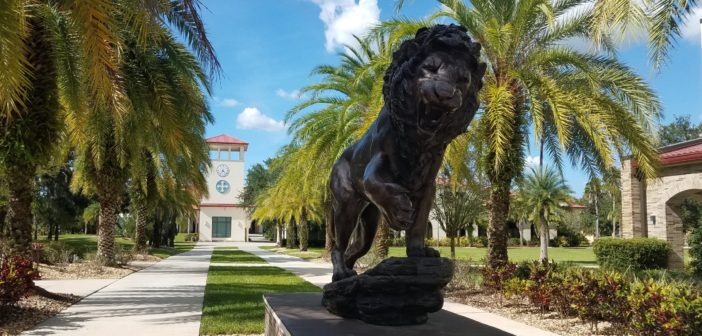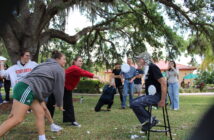By Alora Peters, Contributing Writer
On June 24th, students from Saint Leo University received an email titled “Preparing to Return to the Pride.”
The email was described as a “framework… that will allow the university to safely and cautiously return to the engaging community that we once knew.” The Return to the Pride document, written in response to the COVID-19 pandemic, detailed ways that Saint Leo’s University Campus community can practice social distancing and prevent the spread of illness, all while maintaining a vibrant atmosphere and delivering quality education.
One of the university’s attempts to lessen social gatherings of large groups on campus was to “reduce the number of students in a classroom at any given time” by creating alternate groups—Group A and Group B—for every class. According to the document, only half of the class will be physically present in the classroom, while the other half will watch the lecture virtually via the remote platform Zoom. The two groups will switch “every other class meeting.”
Return to the Pride also stated that each individual student’s schedule “will be adjusted to include one online course that will be taken during the first eight-week session of the Fall semester.”
These new guidelines have left many students wondering what exactly the new school year will look like when they return to campus in August. However, another important question needs to be addressed—with the shift from in-person to online classes, how exactly will a university campus education differ from a traditional online college experience?
Saint Leo prides itself on offering “cutting-edge online university experiences,” where “the only difference between an online degree and a traditional degree is that the online courses are competed remotely.” A student wishing to complete a college education online can enroll at any point throughout the year and choose from a variety of majors that are also offered to students attending at the university campus.
Online courses are typically offered in 8-week segments, the equivalent of half of a 16-week semester, so the coursework is generally consolidated and is less spread out than it is in a traditional course.
Saint Leo faculty and staff are currently hard at work determining how to best translate in-person classes into this virtual realm.
“In summary, a LOT of work goes into the transition from on-ground to online,” said Dr. Allyson Marino, an assistant professor in the department of English at Saint Leo.
Currently, Marino and other faculty are undergoing training and gathering new course materials in order to keep classes interactive even in when they are not face-to-face. Some of the tools professors plan on using include synchronous meetings via Zoom and online discussions in small or large groups.
The transition will not be the same for every online class, however.
“Some classes, such as most University Explorations courses, have existing online versions that take place over 8 weeks in Fall I or Fall II,” said Marino. These classes will more closely resemble the typical courses taken remotely by WorldWide students.
On the other hand, “some classes will be offered as sixteen-week online classes,” said Marino. “These will contain the same amount of work as if they were offered face-to-face,” meaning they will likely be similar to some of the online courses that students completed during the second half of the spring semester.
Due to the unpredictability of the coronavirus conditions, however, much of these plans for university campus remain up in the air.
“Our course schedules still appear to be fluid as the university works out the best way to keep students and the campus community safe,” said Marino. “The schedule you see online may not reflect the actual schedule we’ll see when the semester starts.”
Currently, courses may continue to be flipped between completely online offerings and the hybrid group setup. While there is not much that students can do about this at the moment, it is important for students to be aware of the changes as they are being made.
“Students need to keep checking their schedules as much as possible,” said Dr. Chantelle MacPhee, the department chair of Language Studies and the Arts. “Students also need to check their emails to make sure that they are up-to-date on everything that is transpiring.”
Among these recent, important changes was a reorganization of class periods. In-person course start-times were altered to provide students with twenty minutes in between each class—as opposed to the former ten-minute window—in order to encourage proper social distancing.
Meanwhile, Saint Leo’s nationwide learning centers are also implementing new procedures in response to COVID-19. The education centers—found in various locations across Florida, California, Georgia, Mississippi, South Carolina, Texas, and Virginia—will be using the same group rotation as university campus.
“Beginning with the Fall term, the A and B groups will be implemented to ensure social distancing is practiced,” said Andrea Colón, WorldWide Communications and Training Specialist.
Flexibility is one of the key differentiations between the learning centers and the university campus, Colón said. Education centers offer both online and in-person classes, in either eight-week terms or full sixteen-week semesters. On-ground classes are typically held on weekends or in the evenings—more convenient times for education center students, many of whom are “working parents, active-duty service members, military veterans, career changers, and first-generation college students.”
The differences between Saint Leo’s three educational options are, however, becoming less distinct as the COVID-19 pandemic slowly pushes academic learning from face-to-face to virtual.
In the meantime, Return to the Pride reminds students that “the university is fully prepared to resume fully online education at any point in the semester.” By integrating virtual and in-person education from the very beginning, students and staff will be prepared for any sudden transitions.
This is a troublesome ruling for a number of Saint Leo’s university campus students, many of whom are worried that they will not receive the same quality of education should classes be forcibly moved online.
Many also worry that—despite the overabundance of caution the university has taken and will be taking in the Fall—the coronavirus will inevitably spread, resulting in a campus that is effectively shut down and completely virtual like it was back in the Spring.
Furthermore, the Return to the Pride guidelines give a harrowing closing message to the students who will be unhappy with such a transition: “in the event [that]we must take extraordinary measures… refunds for housing, dining, or tuition will not be available.”
For those attending the university campus, tuition is approximately $12,000 per semester for a student completing 12-18 credit hours—about four to six classes. This means that if tuition simply refers to the price of courses alone and excludes all of the extracurricular activities and various forms of entertainment that campus life has to offer, each 3-hour course would cost about $2,000 for a student taking six classes or $3,000 for a student only taking four.
In the Saint Leo WorldWide program, which encompasses fully online schooling, tuition is calculated by the credit hour, with each credit hour typically costing $380. This would compute to a little over $1,100 per 3-hour course.
Classes are projected to begin on August 25th at Saint Leo’s university campus.





